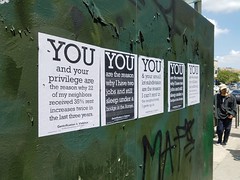Problem
While it is natural and even healthy for some communities to evolve, far too often is this evolution to the detriment of the existing community. Nationwide, gentrification sweeps through cities, leaving behind “improved” neighborhoods that lack most of the community that originally resided within. Bristol Live describes the root of gentrification as the ability of higher-income individuals to “become more organised, arranging historic preservation groups, as well as business and neighbourhood associations.” The problem, however, is that the lower-income groups lack the time and resources to arrange in a similar manner, handing over all power and preparation to the wealthy.. This also means that lower-income individuals often do not know about these plans until after they have gained momentum, further lowering their opportunity to fight back. For people living in low-income, rent-controlled communities, gentrification means more than loss of local business or the inconvenience of walking an extra block to find a laundromat. In many cases, it can mean drastic increases in rent prices and often eviction, draining the rich communities that may have once existed, putting in their places rich communities filled with Starbucks and shopping malls.
Context
The problem of gentrification can be complicated––the people most affected by gentrification are often the same ones who can combat it the least; they work long hours, living paycheck-to-paycheck, and are unavailable to be informed or involved. The bright side is that there are many ways to combat this gentrification while boosting economic growth, laid out by Everyday Feminism. These tactics involve community involvement, preservation of public property, confrontation of elected officials, and more. If there were a way to more easily be informed and involved in one’s community, perhaps communities can better retain their vibrancy and culture. The solution likely stems from those affected uniting and demanding community control.


Image Credits: